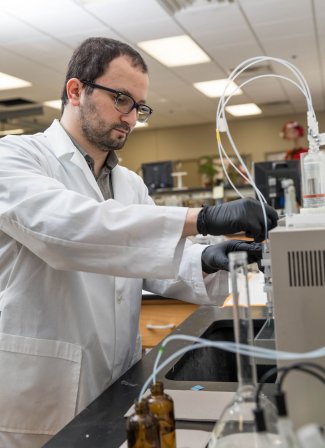Wastewater treatment plants use disinfectants, such as chlorine, to kill harmful microorganisms before releasing their effluent water into rivers and streams. However, these disinfectants can also react with organic matter in the water, forming byproducts that can cause cancer and other diseases.
“We need to control these compounds from the wastewater effluent because these toxic compounds may negatively impact the aquatic ecosystem and public health once discharged into the surface water. When water treatment plants use the surface water downstream of the wastewater plant, these toxic compounds could end up in drinking water,” according to South Dakota State doctoral student Ibrahim Abusallout. As part of his dissertation work in the Department of Civil and Environmental Engineering, he has been investigating the use of natural sunlight and titanium dioxide to break up disinfection byproducts.

He will present the results of this research at the American Chemical Society National meeting this month. His research adviser is assistant professor Guanghui Hua. The research is funded through the Performance Evaluation of Water and Wastewater Treatment contract between Brookings Municipal Utilities and the SDSU Water and Environmental Engineering Research Center.
“I’m trying to find a cost-effective, energy-efficient process to remove these toxic compounds,” said Abusallout, who works as a graduate assistant at the Brookings Wastewater Treatment plant. “This was a tremendous learning experience for me. I learned how the systems work and what problems they face and how to solve them.”
Abusallout evaluated the effectiveness of titanium oxide and sunlight on four disinfection byproduct classes. Chlorine and chloramine, two commonly used wastewater disinfectants, react with naturally existing organic materials to form chlorinated and chloraminated disinfection byproducts. Bromide and iodide ions that exist naturally in surface water react with organic materials to form brominated and iodinated disinfection byproducts. “These are more toxic than the chlorinated and chloraminated ones,” Abusallout said.
Titanium dioxide, which is cheap and readily available, functions as a catalyst, he explained. “When we add titanium dioxide to the disinfection byproduct samples and put them outside, the sunlight reacts with the surface of the titanium dioxide and forms radicals that break down the compounds.” Breaking those chemical bonds results in elements, such as carbon dioxide, water and inorganic halides, all of which are harmless.
Although the process is effective for all disinfection byproduct classes tested, brominated and iodinated compounds are more degradable than the chlorinated ones. “The two that are the most toxic break down faster,” he said.
Iodinated disinfection byproducts were completely removed after 20 minutes of natural sunlight exposure, chloraminated disinfection byproducts after 30 minutes and brominated disinfection byproducts after 60 minutes. However, Abusallout noted, chlorinated disinfection byproducts are most resistant to this process, with only 60 percent broken down after 60 minutes in natural sunlight.
"Though we still have some chlorine compounds, the removal rate is sufficient to control the levels of disinfection byproducts in treated wastewater effluent,” he said. However, he cautioned, the system is still in the early stages of development. More research is needed to apply this technology for wastewater treatment.
Abusallout envisions a continuous flow system using clear tubing, with the length determined based on removal time, but an open storage area might also work.
He is also testing another process that uses sunlight along with hydrogen peroxide. Once he determines which process is most effective at removing disinfection byproducts, he will see how it can be applied in a wastewater treatment plant.
Republishing
You may republish SDSU News Center articles for free, online or in print. Questions? Contact us at sdsu.news@sdstate.edu or 605-688-6161.

